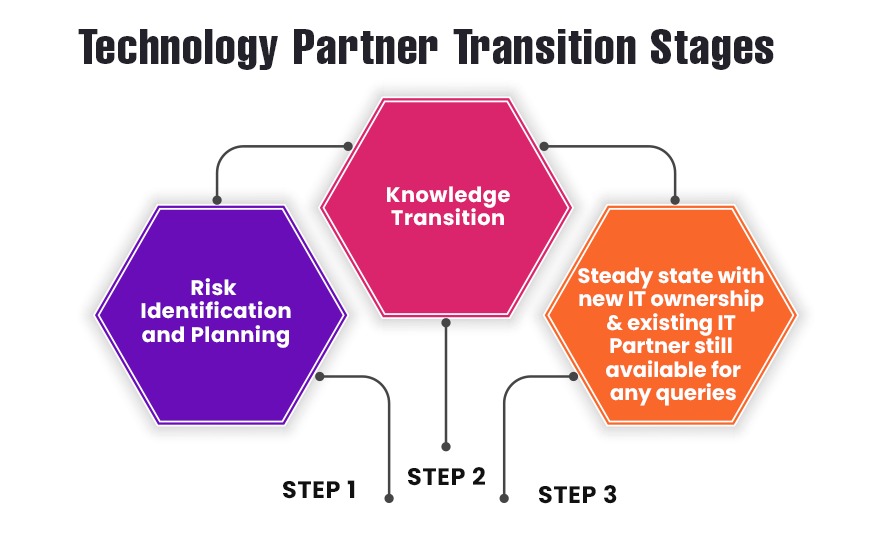
You don’t sit down one day with your morning cup of joe and decide to call its quits with your current software vendor. Either there are red flags that have added up to the decision or your company has decided to transition maintenance to a new software company. Switching vendors is fraught with challenges, so obviously it is never taken lightly. After all, a successful project transition plan can take 2 to 3 months. The more complex the project is, the longer the transition time. Sometimes it might make more sense to scrap the existing project and start anew or find ways to repair your current relationship. Before making the call to move. Here are a few things to consider before putting in place steps for a smooth transition.
Why do companies decide to change technology vendors?
There are numerous reasons when a transition becomes a necessity but we have come across these 7 common reasons why companies decide on a switch.
- Companies want to switch from one tech stack to another based on new business strategies. Often the existing vendor does not have the technical skill sets to partner on this evolution.
- Often cost impact is what makes a transition decision an imperative. For instance, vendor pricing transparency is non-existent and you get hit with bills you never expected.
- There is an inordinate delay in your project. Oftentimes complex issues might take time to resolve but if small issues are taking days to resolve and they keep recurring, this could be a wake up call. Poor communication and not keeping to the service level agreements (SLAs) might give you legal grounds to call a halt.
- Nothing is documented properly. Sometimes you might have contracted with a small IT provider that suited the size of your organization but as your company has grown, they have not. In part this could be indicated by them carrying out ad-hoc work with no proper documentation. This is a red flag as any project transition plan could meet a road block.
Also read: Time and Materials vs Fixed Price: Which is Best When Outsourcing IT?
You’ve decided to transition to a new IT vendor, now how do you take it forward?
Before transitioning to a new IT vendor, make sure that your current partner relationship cannot be saved. Most times the switch is considered on the basis of improved cost efficiency and growth but switching mid-project always comes with a degree of risk. Will your new tech partner deliver the goods? While building a solid business case for this change to present to your C-suite, here are critical aspects to be considered.
1. Termination fees can be sizable so make sure you arrive at the right cost estimate for breaking the vendor contract mid-project. There might be a breach of contract from the vendor but dispute resolution can take time.
2. A transition could impact your business in different ways. For instance, certain business workflows might grind to a stop if IT support is lost during the transition. You need to have a business disruption minimization model to minimize any impact and restore quickly the affected services.
3. How willing is your old vendor to cooperate in the knowledge transfer to the new one? This clause is usually built into the SLA but an angry vendor might not be ready for a smooth project transition. This could call for a lot of negotiations but if the vendor’s reputation is protected then they usually will show more willingness.
4. One thing is guaranteed – if you ever find yourself in the difficult situation of switching vendors mid project then you want to make sure you are never in such a situation again. It is important to learn from your experiences and recognize the red flags before they become insurmountable. One way to do this is to have a clear cut vendor management strategy in place.
Also read: Will Low Cod/No-Code Solutions Overtake Custom Software?
What is involved in a smooth transition management plan to a new vendor?
Choosing a new software development team should connect you to a more skilled team of software engineers and better operation management. Of course, even with in depth analysis, the proof of the pudding is in the eating.
For a successful project transition to the new team, the previous vendor IT team must also be closely involved. The transition phase must cover these three stages and depending on complexity can take at least 2-3 months.

Step 1: Risk identification and preparation of transition management plan
This is an intensive period where the new team will have numerous meeting with the client to understand the client processes for the different application. It is during this phase that they will take a deep look into the existing documentation, cloud infrastructure and do a risk analysis with code review. After this is completed the new IT team will create a detailed transition management plan that will include the knowledge transfer required from the previous IT vendor team. The project transition plan will be broken up to cover each application involved in the client’s project.
Step 2: Knowledge transfer and taking ownership
Generally, when managing transition, a minimum of 3 applications are scheduled each week for knowledge transfer from the previous vendor. This should help you to calculate how long it will take for a full knowledge transfer. Once this has been completed, the new IT team will take over ownership and this will include handling all day to day operations for the smooth running of the applications. However, the transition is not completed yet. The previous IT team will still need to have daily status calls with the new team for at least a week to provide clarity as the new team begins operations.
Step 3: Steady state with minimal support from old team
The new IT team will now do an impact analysis for any changes in architecture, code review to understand if it can withstand changes and then manage transition for process improvements. Very limited support might still be needed from the old team for at least a couple of weeks. By this time the client should have established a good working relationship with the new IT team. It will require a new vendor management strategy to have been put in place that takes past experiences into account and with the goal to keep the project on budget and effectively meet deadlines.
Switching your IT vendor need not be a daunting task if checks are put in place. It is important to be 100% sure that the new partner selected will address successfully all operational challenges and minimize business impact. Software development teams like iTech India, creates a custom package based on your current IT set up and new goals. The date of transition is set in stone when the transition plan is created. We have taken over many client projects midway through development as well as in the maintenance phase. Call us to know more about how a smooth transition plan can be put in place.





